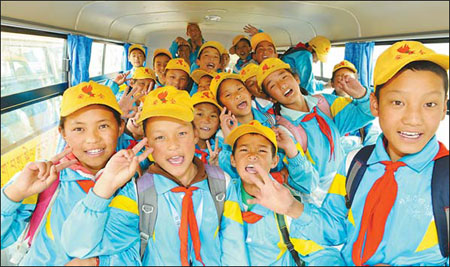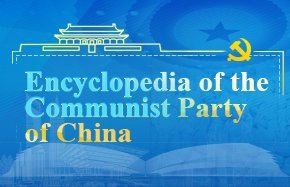Tibet still on steady path to growth
|
Students in Tibet pay no tuition and boarding fees for education until they go to university. |
Income growth rate in double digits for the ninth consecutive year
The Tibet autonomous region is on a trajectory to maintain stable and balanced growth thanks to a set of preferential policies from the central government and assistance from across the country.
Chen Quanguo, Tibet's Party chief, said the region's developmental strategy prioritizes transportation infrastructure, energy, telecommunications and tourism. He added that authorities will further support the development of traditional farming and herding, mining, ethnic handcrafts, and Tibetan pharmacology and medicine.
Annual per capita income in Tibet reached more than 4,900 yuan in 2011, continuing the double-digit annual growth seen in the region for the past nine consecutive years. Tibet's GDP stood at more than 60.5 billion yuan in 2011 and has grown at an average annual rate of 12.4 percent since 2006.
Since 2006, 21.9 billion yuan has been appropriated for a massive project to provide better housing for more than 350,000 farmers and nomads, Chen said.
By the end of 2013, all residents in Tibet will move into new houses or restructured ones equipped with water, electricity, gas, postal and television access and highway connections, Chen said.
This winter, 40 percent of the residents in Lhasa will have access to a central heating system, which will cover the whole capital city by the winter of 2013.
Better education
Extending opportunities for basic and higher education and creating jobs for university graduates have been at the top of the agenda for regional authorities.
In 2011, 786 million yuan was spent to boost the job market, and 18,000 university graduates found work. More than 21,500 new jobs in urban areas were created in 2012, said Fan Guangcai, deputy director of the finance department of Tibet.
Students in Tibet pay no tuition and boarding fees for education until they go to university. Since 2011, Tibet has allocated 2.23 billion yuan to foot the bill for free education, Fan said.
Thondup Tsering, principal of Bomi county high school in Nyingchi prefecture, said Tibetan education has experienced its fastest period of development in recent years.
The school's shabby buildings with broken doors and windows have been replaced by modern facilities with science labs, interactive whiteboards, a piano and dancing classrooms, an indoor basketball court, a football field and athletic tracks, he said.
Students no longer live in small, dark dormitories, and a solar heating system allows them to take hot showers year-round , he said.
Tibet has a healthcare system that offers free, universal medical services for its population of 3 million people, who have an average life expectancy of 67 years, nearly double the estimated life expectancy in 1959.
Free treatment will be given to 7,000 children with congenital heart diseases before 2014.
Monasteries of Tibetan Buddhism have been renovated with improved infrastructure and better protection of relics. Tibet is home to 1,700 Buddhist sites as well as more than 46,000 monks and nuns, and most ethnic Tibetans are devout followers.
Clergy members in Tibet are covered by a social security system that includes old-age pension, medical insurance and a minimum living allowance. About 1,900 monks and nuns aged over 60 are entitled to a basic pension allowance of 120 yuan a month starting from March 2012.
Plateau railway
The Qinghai-Tibet Railway has given Tibetan people the hope of a better life with more opportunities. The nearly 2,000-kilometer railway on the world's highest plateau has transported more than 52 million people and 240 million tons of goods since it first became fully operational in 2006.
Sodnam Deorma, now 29, was one of the first passengers to use the railway on that day. It greatly shortened her travel time between Lhasa and her university in Chengdu, Sichuan province.
After graduating, she became one of the first 38 ethnic Tibetan employees at Lhasa Railway Station. And one of the comments she hears frequently from the passengers is "without the railway, I would not be able to see Tian'anmen Square in Beijing and climb the Great Wall".
A grid extending more than 2,500 km linking Lhasa with Xining in Qinghai province was established in 2011, with an investment of 16.2 billion yuan.
Many Tibetan areas had no supply of electricity until recently. In past years, they relied on solar and wind power to generate electricity for short-term lighting due to the limited capacity, short lifespan and long charging time of batteries.
Now they are able to use electricity to cook food, make buttered tea and watch television.
Su Shan, a senior researcher at the Party school of the region, said Tibet still faces serious challenges in the long run, such as rural and urban integration. Its urbanization rate is 25 percent, less than half of the national average, he said.
Tibet is at the beginning of industrialization. It has a weak basis and lacks innovative abilities. Also, its economy is driven by government-led initiatives. The amount of capital exceeds that of private investment, which totaled 12.68 billion yuan in 2011, Su said.
Tibet will send 28 elected delegates, including seven women, to attend the 18th CPC National Congress, to be held in Beijing on Nov 8.
Since October 2011, more than 21,800 officials in Tibet have been sent to the grassroots level, where they work in pastures and farming villages.
Their first-hand experiences and interactions with the villagers have provided food for thought to guide their work and address practical problems in the future.
Contact the writers at liyao@chinadaily.com.cn





















